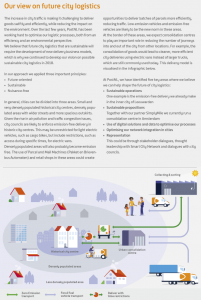In October 2018 PostNL announced long-term goals to deliver emission-free in 25 Dutch city centers by 2025, and deliver emission-free in the last-mile throughout the Benelux by 2030. In their new annual report, PostNL announces more actions towards becoming green in city logistics.
Cleaner vehicles
Continuous investment in cleaner vehicles has helped reduce emissions from the PostNL fleet, and in 2018 they continued replacing diesel vans with cleaner alternatives, for example, biogas vans or, where feasible, e-cargo bikes. PostNL also introduced electric vans and installed power chargers at their new parcel center in Amsterdam (NL). And the first trucks using liquefied natural gas (LNG) were introduced. They will continue to increase the number of electric and low-emission trucks and vans we use to collect and deliver mail and parcels.
PostNL is making its delivery fleet more sustainable. In 2018, they made use of 263 e-bikes, 24 electrical scooters, 65 electrical cargo bikes, 828 vans driving on biogas, and 12 small electric vehicles. Additionally, all vehicles meet the Euro 5 or Euro 6 standards, and 44% of delivery vans drive on green gas. The expansion of the electric vehicle fleet will help PostNL move towards our long term goal to deliver zero-emission. In 2017 PostNL started using e-cargo Stints to deliver parcels and mail across a number of city centers in the Netherlands. This proved to be a promising vehicle for PostNL.
Smart packaging
In many cases, parcels sent by customers contain a lot of air. In addition, most packages are disposable. PostNL identified opportunities to manage packages more efficiently. They are in discussions with large customers about how they can remove air from their parcels by using smaller packages. This saves space in delivery vans, and at the same time CO2 emissions during delivery and waste treatment.
City Logistics
PostNL identified that the combination of the expected long-term growth in the e-commerce market and our current business model are not sustainable in densely populated cities, given the impact it would have on climate change, air quality and traffic congestion. As a consequence, PostNL decided to take a pro-active approach towards the debate on future city logistics. In 2018, PostNL developed a view on possible alternative business models that facilitate growth, while minimizing the negative impact on climate, air quality, and congestion. See below.
E-commerce: CO2 impact of parcels
PostNL works together with various organizations to help the e-commerce sectors reduce its environmental impact. We participate in the branch organization Thuiswinkel.org together with other big players in the e-commerce sector. We sponsor the organization for the development of a tool to calculate the CO2 impact of each parcel which is used to monitor the climate change impact of e-commerce and create consumer awareness by showing the CO2 footprint in their webstore checkout page.
Source and picture: PostNL

